It’s your special day so ENJOY!I am so fortunate to have a mom who is also a good friend.We have an appointment at the spa when you come out to Charleston.Can’t wait to see you!Hugs & Kisses from both of us!+++++++++++++++++++++++++++++++++++++++++…
Archive | Grateful RSS feed for this section
HAPPY MOTHER’S DAY
It’s your special day so ENJOY!I am so fortunate to have a mom who is also a good friend.We have an appointment at the spa when you come out to Charleston.Can’t wait to see you!Hugs & Kisses from both of us!+++++++++++++++++++++++++++++++++++++++++…
May 4-5, 2010
St. Augustine to Fernandina Beach Our last night in Florida was at Fernandina Beach. We had a long and hot (90 degrees and following wind) cruise from St. Augustine to Fernandina Beach. In fact, Mark took unusual measures (blue gel cool pack) to…
May 4-5, 2010
Our last night in Florida was at FernandinaBeach. We had a long and hot (90 degrees and following wind) cruise from St. Augustine to FernandinaBeach. In fact, Mark took unusual measures (blue gel cool pack) to try to stay cool, but didn’t look so cool.
.jpg)
The farther north we have traveled, the greater the tidal change has been. It was about 5-6 feet in St. Augustine, and was 7-9 feet at FernandinaBeach. The docks lining this ten-mile, no wake canal near PalmValley were evidence of the huge shift between high and low tides. We were passing these docks at near low tide, and noticed that some folks had rather ingenious dock designs.
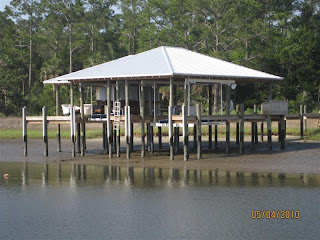.jpg)
.jpg)
.jpg)
As we crossed the St. John’sRiver – major inlet to Jacksonville – we passed before the tanker, Golden Energy, and under the bascule bridge. These two photos were taken by BeJay & Mike (s/v Carolina Moon). We are the little white boat……
.jpg)
.jpg)
.jpg)
We have made it to Georgia – JekyllIsland! More on that later.
April 27-May 4, 2010
St. AugustineWell, what can I say about St. Augustine?? If you haven’t been there yet, make plans to go. It is a great city – although, the only parts we saw were the older, historical areas. Our trip from Daytona Beach to St. Augustine was fai…
April 27-May 4, 2010
Our trip from Daytona Beach to St. Augustine was fairly uneventful. The homes along the way were lovely, but not ostentatious. The scenery became more rustic – dotted with trees, lowlands and marshes. The waterway channel was narrow and at low tide we could see oyster beds.
.jpg) The largest fire fighting ship in the world pulled into the marina the first night we were there, and then left after a few hours.
The largest fire fighting ship in the world pulled into the marina the first night we were there, and then left after a few hours.
.jpg) As the day progressed, the wind got nasty and when we landed in the St. Augustine Municipal Marina we had a strong current also to content with. Mark, as usual, pulled us in with little difficulty. After spending a week in the marina, we were pleased that we had done so well as there were others who did not. The day after we were there a sailboat two slips away from us got caught sideways on a big iron pole at the end of the finger pier of his slip. He got out of it without too much damage. The sailboat next to us (no finger pier or soft pole between us) had a terrible time backing out of the slip. The dock tenders held lines for him, but still he needed to give it all he had to get out and not hit us. I braced for impact!!! Later in the week a larger yacht somehow got in trouble and ended up with the front of his yacht up against the end of a finger pier and the back up against another finger pier. He put fenders out and waited for Towboat US to get him out of the mess – the damage was minimal. Then two days later a beautiful Grand Banks Trawler got caught in the current and found himself up against the Bridge of Lions. When he tried to back up he went at ramming speed right into a post. Well he was tightly wedged against the bridge and post, but again Towboat US was able to pull him off and then he was able to get into a slip. He had a big chunk broken out of his transom/platform – pretty remarkable considering how badly he hit and was stuck. Needless to say, this had me worrying and planning about our exit strategy!!
As the day progressed, the wind got nasty and when we landed in the St. Augustine Municipal Marina we had a strong current also to content with. Mark, as usual, pulled us in with little difficulty. After spending a week in the marina, we were pleased that we had done so well as there were others who did not. The day after we were there a sailboat two slips away from us got caught sideways on a big iron pole at the end of the finger pier of his slip. He got out of it without too much damage. The sailboat next to us (no finger pier or soft pole between us) had a terrible time backing out of the slip. The dock tenders held lines for him, but still he needed to give it all he had to get out and not hit us. I braced for impact!!! Later in the week a larger yacht somehow got in trouble and ended up with the front of his yacht up against the end of a finger pier and the back up against another finger pier. He put fenders out and waited for Towboat US to get him out of the mess – the damage was minimal. Then two days later a beautiful Grand Banks Trawler got caught in the current and found himself up against the Bridge of Lions. When he tried to back up he went at ramming speed right into a post. Well he was tightly wedged against the bridge and post, but again Towboat US was able to pull him off and then he was able to get into a slip. He had a big chunk broken out of his transom/platform – pretty remarkable considering how badly he hit and was stuck. Needless to say, this had me worrying and planning about our exit strategy!!
On my first morning walk with Porter, I accidentally found the Oldest House, dating from the early 1700s, and a neighborhood of oldest homes from the time of Spanish rule.
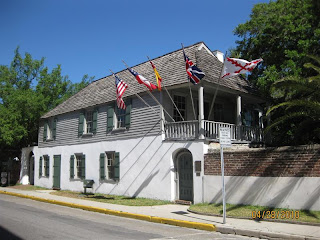.jpg)
This park with the Live Oak tree was dedicated to the city – peaceful.
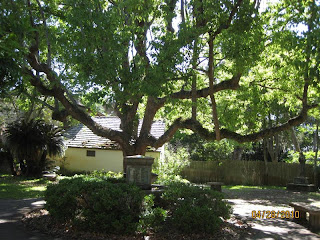.jpg)
And I found this house for sale. It is on the Historical Register – built around the 1880’s and the price had just been reduced to $699,000.00. It was beautiful and sprawled out to 5800 sq. ft.
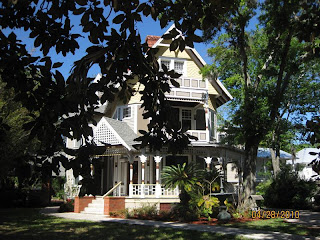.jpg)
Because we were in the city during the week, we decided to do our sight-seeing before the crowds came for the weekend. We took the sight seeing train rather than the trolley because tickets could be purchased right outside of the marina and we could ride for three consecutive days – PERFECT! The plan was to see two things or so in a day and not to start before noon – I had to keep my partner participating with meJ On day one we took the train to all it’s stops so we could figure out what we wanted to spend time seeing. We got off on
and found many little shops and restaurants. We ate brunch at the Bunnery and then settled on 2/1 Asiago Cheese soft pretzels for dessert. (Our week’s stay here has not done our weight loss program any good). Then back on the train – I think I got most of my best pictures while rolling around on the train. These are some of the sights we saw:
Magnolia Street lined with live oak trees.
.jpg) Gates to the City – the gates and a wall were built around the town of St. Augustine after the British burned the whole city to the ground in 1702.
Gates to the City – the gates and a wall were built around the town of St. Augustine after the British burned the whole city to the ground in 1702.
.jpg)
.jpg) On our second day we toured the Castillo de San Marcos. This fort was built with coquina stone, found only two places in Florida, and was started in 1672 and completed in 1695. Its location on the west bank of the Matanzas Bay allowed it to protect the harbor and the land to the north from attack. Apparently, the coquina stone helped the fort withstand fire and cannon balls. Later the Spanish also fortified the grounds around the fort with a moat and several levels of land. All nations that occupied the area at one time or another used the fort in one way or another – lastly as a prison for both American Indians and prisoners during the Spanish-American War.
On our second day we toured the Castillo de San Marcos. This fort was built with coquina stone, found only two places in Florida, and was started in 1672 and completed in 1695. Its location on the west bank of the Matanzas Bay allowed it to protect the harbor and the land to the north from attack. Apparently, the coquina stone helped the fort withstand fire and cannon balls. Later the Spanish also fortified the grounds around the fort with a moat and several levels of land. All nations that occupied the area at one time or another used the fort in one way or another – lastly as a prison for both American Indians and prisoners during the Spanish-American War.
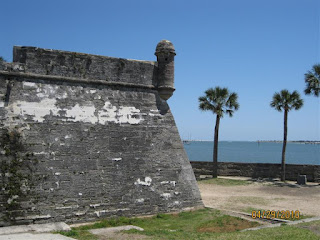.jpg)
.jpg) Next we went to the Fountain of Youth Park – we happened to join a busload of “old farts” – fit right in – all looking for that fountain….. This park is where some of the oldest artifacts from St. Augustine have been found. It is still an active dig. We drank the water of the fountain – I’m sure it helped us get through the rest of the day. It was courting season in the park for the peacocks – they were noisy, but beautiful.
Next we went to the Fountain of Youth Park – we happened to join a busload of “old farts” – fit right in – all looking for that fountain….. This park is where some of the oldest artifacts from St. Augustine have been found. It is still an active dig. We drank the water of the fountain – I’m sure it helped us get through the rest of the day. It was courting season in the park for the peacocks – they were noisy, but beautiful.
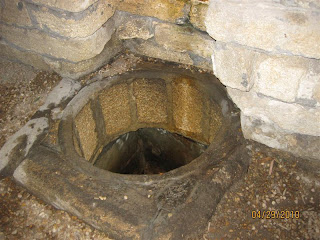.jpg)
.jpg)
.jpg) Shortly after the Hotel Ponce de Leon was built this structure was built as an activity center for the hotel – with steam rooms, smoking rooms and other recreation rooms as well as the largest indoor swimming pool of its era. Women were allowed to use the steam room and pool for a couple of hours a day. The building was lovely and restored to its original beauty except for the pool. There are shops occupying that area now. There was quite a collection of old stuff here. At one point when I had stopped to check my appearance, Mark told me that I wasn’t looking at an artifact, but that it really was a mirror. (Thanks, Dear). He especially liked this original hooked rug and wanted his picture taken by it. I don’t get it – I thought he liked my family and his son-in-laws????
Shortly after the Hotel Ponce de Leon was built this structure was built as an activity center for the hotel – with steam rooms, smoking rooms and other recreation rooms as well as the largest indoor swimming pool of its era. Women were allowed to use the steam room and pool for a couple of hours a day. The building was lovely and restored to its original beauty except for the pool. There are shops occupying that area now. There was quite a collection of old stuff here. At one point when I had stopped to check my appearance, Mark told me that I wasn’t looking at an artifact, but that it really was a mirror. (Thanks, Dear). He especially liked this original hooked rug and wanted his picture taken by it. I don’t get it – I thought he liked my family and his son-in-laws????
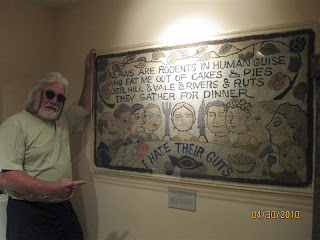.jpg)
We then walked to the San Sebastion Winery as we didn’t want to go to all the train stops. As always we love these tours and tastings, and it goes without saying that we needed the train afterwards to get our new case of wine back to Grateful.
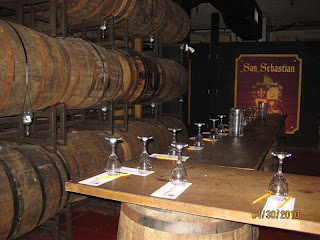.jpg)
.jpg)
.jpg) The wind and current have been constant all week. We took the weekend to do some chores on Grateful. I washed windows, applied metal wax to the chrome and worked a little on the teak. Mark tackled the damage the flying spotted eagle ray caused to the dinghy when we were in the Bahamas. The good news was that the depth/fish finder worked after being so rudely ripped from its cables and then thrown in the sea water. Also, Mark was able to stabilize the console. Grateful’s tender is now in great working order.
The wind and current have been constant all week. We took the weekend to do some chores on Grateful. I washed windows, applied metal wax to the chrome and worked a little on the teak. Mark tackled the damage the flying spotted eagle ray caused to the dinghy when we were in the Bahamas. The good news was that the depth/fish finder worked after being so rudely ripped from its cables and then thrown in the sea water. Also, Mark was able to stabilize the console. Grateful’s tender is now in great working order.
Finally on Monday we went back to the Flagler College (Hotel Ponce de Leon). The building we toured is currently being used as a women’s dormitory, administrative offices and dining hall.
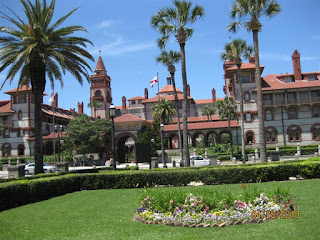.jpg)
.jpg)
.jpg)
This place is incredible and it is impossible to describe here all that we learned. Just know that no expense was spared to build this hotel – I believe I heard $2.5 million dollars. It was the largest structure of its time to be built with poured concrete. Lighting was all electrical and installed by Thomas Edison’s electrical company. Water was brought in and stored in the two towers of the hotel – one for hot water and one for cold. There were nearly 80 windows done by Tiffany,
.jpg)
and the ceilings and walls were painted by the best artists of the time. Everything that looks like gold is – gold leaf a used everywhere. I was in love with the carved wood pillars, fireplaces, chairs, balconies – the hotel was rich with it.
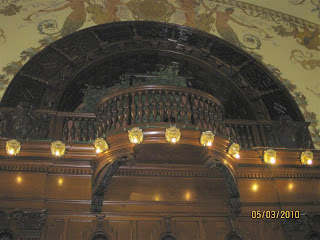.jpg)
I probably should have lived during this era, but I wouldn’t have been able to afford to stay in a place like this. The single room on the first floor cost $5.00/night and the suites on the top floors were $200.00/night, or an equivalent of $150.00 and $6000.00 respectively in today’s money.
Early St. Augustine through pictures:
http://www.wyomingtalesandtrails.com/staguphotos6.html
Henry Morrison Flagler biography:
http://www.flaglermuseum.us/html/flagler_biography.html
The End
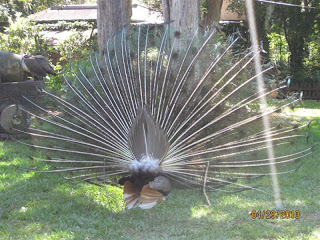.jpg)
April 23-26, 2010 Daytona Beach
We left Titusville on a very calm morning and had another nice cruise. The NASA Railroad Bridge was open as it usually is. We have read that on April 28-30, the bridge will be closed for repairs.The Haulover Canal is a connecting canal between the nor…
April 23-26, 2010 Daytona Beach
.jpg)
.jpg)
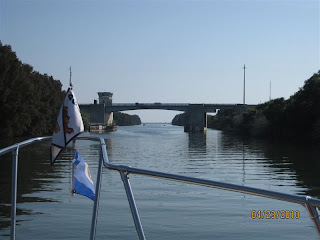.jpg)
.jpg)
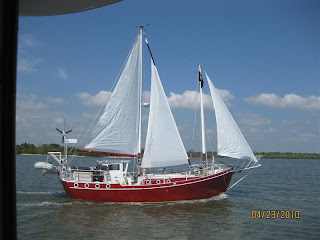.jpg)
.jpg)
.jpg)
.jpg)
.jpg)
.jpg)
.jpg)
.jpg)
.jpg)
.jpg)
.jpg)
.jpg)
.jpg)
.jpg)
April 21-22, 2010 Titusville and Kennedy Space Center
NASA Kennedy Space CenterWhat a terrific visit we had in Titusville! The marina and staff were wonderful, and the location was great to get to the Kennedy Space Center. We rented a car from Enterprise and got upgraded to a full size car so that was …
April 21-22, 2010 Titusville and Kennedy Space Center
.jpg)
.jpg)
.jpg)
.jpg)
.jpg)
.jpg)
.jpg)
.jpg)
.jpg)
.jpg)
- The winged orbiter (shuttle) has approximately 24,000 silica tiles attached to its thin, aluminum body. The tiles protect the orbiter and crew from the heat of re-entry into the earth’s atmosphere. These specifically designed, reusable silica tiles are made of 90% air and 10% refined sand.
- At lift-off, the large orange-colored external tank (ET) holds over 500,000 gallons of cryogenic fuel – liquid oxygen and liquid hydrogen. The Shuttle’s three main engines consume this fuel in about 8.5 minutes.
- The two Solid Rocket Boosters (SRBs) contain solid fuel, which is consumed at the rate of 10 tons each second at launch. The SRBs have the thrust of 35 Boeing 747s and are jettisoned after 2 minutes, 4 seconds of flight. Later they are retrieved from the Atlantic Ocean.
- Prior to launch the Space Shuttle weighs 4.5 million pounds: 3.8 million pounds are propellants consumed in 8.5 minutes.
- The orbiter travels at 17,500 MPH – 5 miles a second. At that speed the astronauts circle the planet every 90 minutes!
After the bus tour we watched a 3-D IMAX presentation of the Hubble Telescope. Amazing and having not watched 3-D since we were children we were delighted with that aspect.
We would highly recommend visiting the KennedySpaceCenter if you are in the area. We were not able to see and experience everything – although we could have used our admission tickets another day (within a week). NASA has manned space flights planned for the future if funding continues. That may be in jeopardy.
Thursday turned out to be a perfect day for a rocket launch. We were prepared with tripod and the BIG camera lens. Well, we didn’t hear it, but suddenly it was high in the air before we realized it. The sound came later. As we returned to Grateful, others commented to us how lucky we were to see all three stages of the rocket. I believe I saw the third stage – a couple of little sparkles just as the rocket went out of sight. Good Stuff!!
.jpg)
.jpg)
Fun NASA websites:
The dollars invested in the space program yield many new products, technologies and processes – many that I was not aware of. These “spin-offs” include computers, microchips, freeze-dried foods, satellite communications, weather study predictions and many more. I love to read about the advances in medicine. Go to the following websites:
http://www.sti.nasa.gov/tto/spinoff.html
http://technology.ksc.nasa.gov
If you would like to know when the ISS will be flying over your hometown, check out this website:
http://spaceflight.nasa.gov/station
This site tells the status of launches and landings with video:

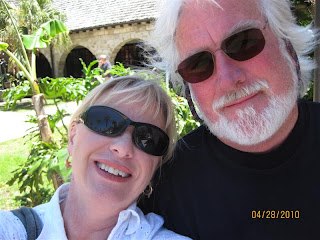.jpg)
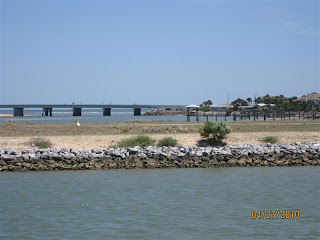.jpg)
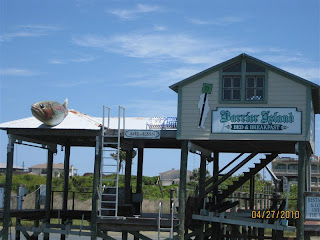.jpg)
.jpg)
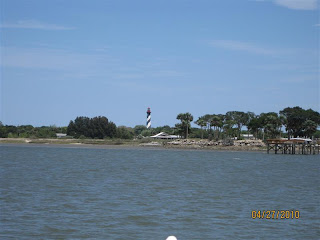.jpg)